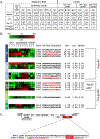Retroviral sero-reactivity in LGL leukaemia patients and family members
- PMID: 31608437
- PMCID: PMC7012702
- DOI: 10.1111/bjh.16223
Retroviral sero-reactivity in LGL leukaemia patients and family members
Abstract
T-cell large granular lymphocyte (T-LGL) leukaemia is characterized by a clonal proliferation of cytotoxic T cells and is frequently associated with rheumatoid arthritis. Sera from some LGL leukaemia patients react to a portion of the human T-cell leukaemia virus (HTLV-1/2) transmembrane envelope protein, BA21, although HTLV-1/2 infection is rare in LGL leukaemia patients. Here we show that family members, including spouses, of an LGL leukaemia patient had elevated LGL counts, BA21 reactivity and, additionally, recognition of HIV-1 gp41. Thus, both LGL leukaemia patients and clinically normal contacts sharing the same environment have evidence of exposure to a retrovirus.
Keywords: epidemiology; leukaemia; retroviruses.
© 2019 British Society for Haematology and John Wiley & Sons Ltd.
Conflict of interest statement
Figures


References
-
- Hahn S, Ugurel S, Hanschmann KM, Strobel H, Tondera C, Schadendorf D, Lower J, Lower R, 2008. Serological response to human endogenous retrovirus K in melanoma patients correlates with survival probability. AIDS Res Hum Retroviruses 24, 717–723. - PubMed
-
- Lamy T, Moignet A, Loughran TP, 2017. LGL leukemia: From pathogenesis to treatment. Blood - PubMed
-
- Le Deist F, de Saint Basile G, Coulombel L, Breton-Gorius J, Maier-Redelsperger M, Beljorde K, Bremard C, Griscelli C, 1991. A familial occurrence of natural killer cell--T-lymphocyte proliferation disease in two children. Cancer 67, 2610–2617. - PubMed
-
- Loughran TP Jr., Kadin ME, Starkebaum G, Abkowitz JL, Clark EA, Disteche C, Lum LG, Slichter SJ, 1985. Leukemia of large granular lymphocytes: association with clonal chromosomal abnormalities and autoimmune neutropenia, thrombocytopenia, and hemolytic anemia. Ann Intern Med 102, 169–175. - PubMed
Publication types
MeSH terms
Substances
Grants and funding
LinkOut - more resources
Full Text Sources

